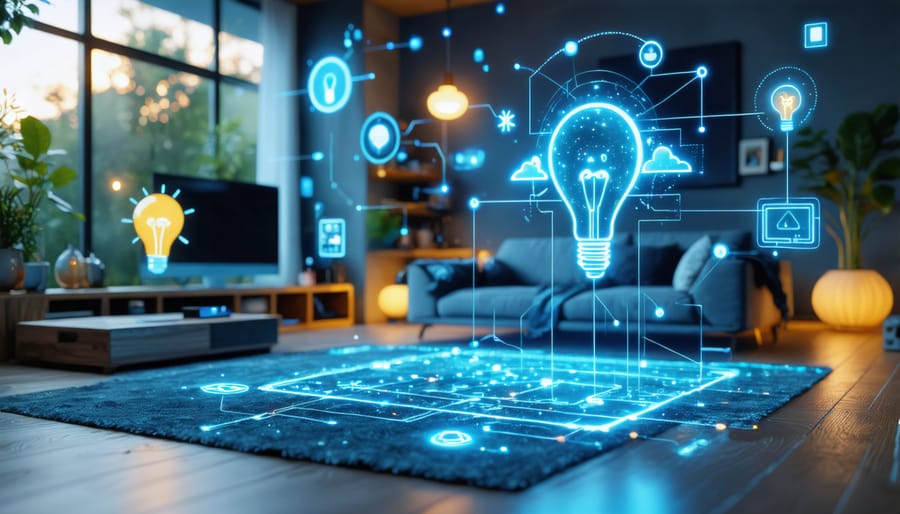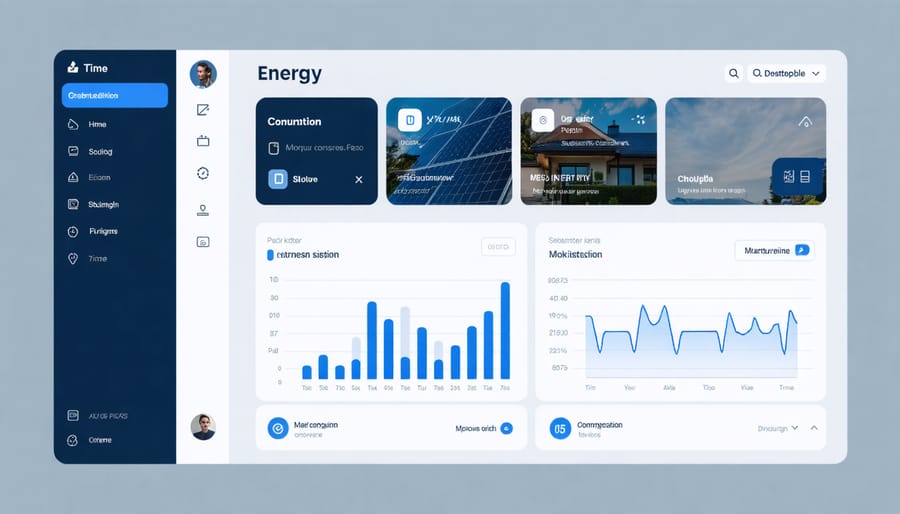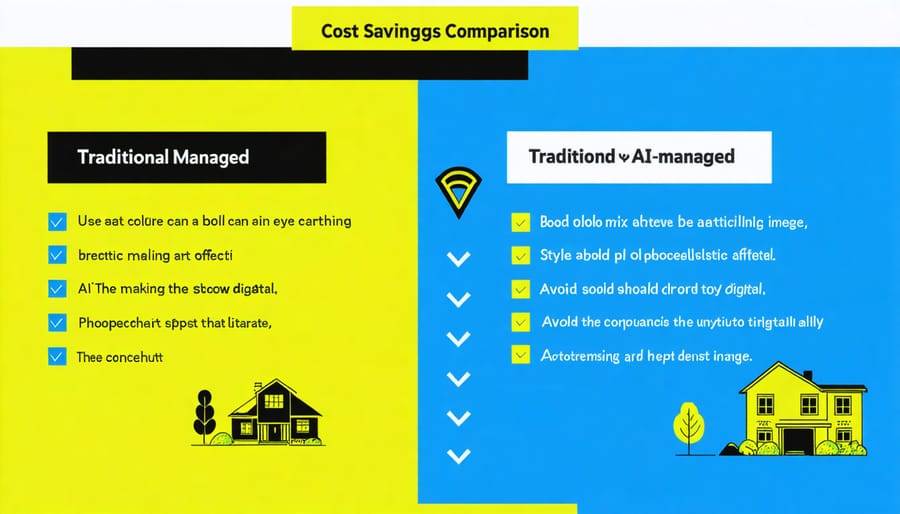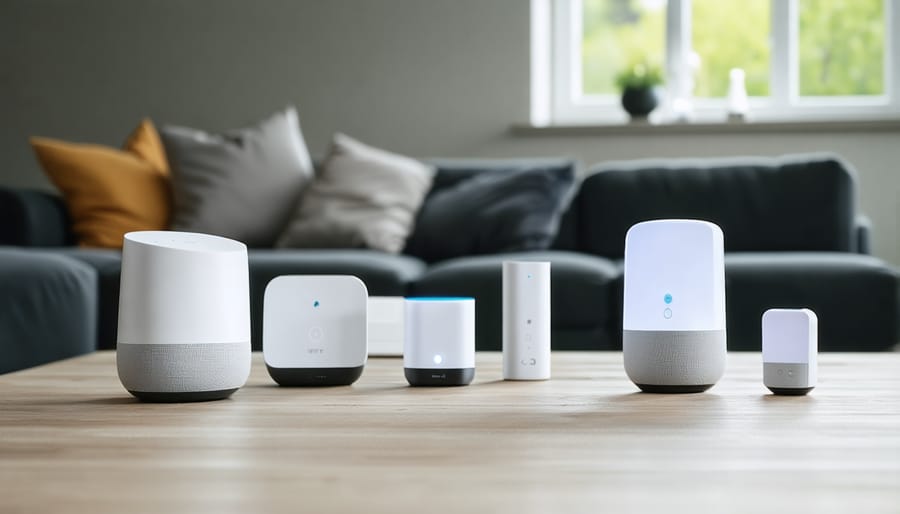
Smart Home Energy Systems That Actually Save You Money
Transform your home into an energy-efficient sanctuary with today’s intelligent home management systems. These AI-powered solutions deliver smart home technology benefits that extend far beyond basic automation, cutting utility bills by up to 30% while maintaining perfect comfort levels throughout your living spaces.
Imagine walking into a home that automatically adjusts its temperature, lighting, and energy usage based on your daily routines and real-time utility rates. Smart home energy management systems make this possible by integrating seamlessly with your existing appliances and devices, creating an intelligent ecosystem that optimizes energy consumption without sacrificing convenience.
Whether you’re a tech enthusiast or simply looking to reduce your carbon footprint, these systems offer an accessible entry point into sustainable living. With user-friendly interfaces and straightforward installation options, modern energy management solutions empower homeowners to take control of their energy usage while contributing to a greener future. The best part? Many systems pay for themselves within the first year through reduced energy costs and improved efficiency.
How AI-Powered Energy Management Works in Your Home

Key Components You’ll Need
To build an effective smart home energy management system, you’ll need several key components that work together seamlessly. At the heart of your system is a smart thermostat, which serves as your primary control center for heating and cooling. This connects with smart meters that track your real-time energy usage and help identify opportunities for savings among your eco-friendly home features.
You’ll also need smart plugs or outlets to monitor and control individual appliances, along with a reliable home automation hub that coordinates all these devices. Motion sensors and occupancy detectors help optimize energy use based on room activity, while smart lighting controls adjust brightness and timing automatically.
A stable Wi-Fi network is essential for keeping everything connected, and you’ll want to install a user-friendly mobile app for remote monitoring and control. Some systems also include smart window coverings that automatically adjust based on sunlight and temperature, helping maintain optimal indoor conditions while reducing energy waste.
For data management, you’ll need cloud-based software that processes usage patterns and provides actionable insights through an easy-to-understand dashboard.
Setting Up Your Smart Energy Network
Setting up your smart energy network is simpler than you might think. Start by installing a smart thermostat – this will be the heart of your system. Most modern thermostats come with step-by-step installation guides and can be mounted where your old thermostat was located.
Next, connect your smart thermostat to your home’s Wi-Fi network. Download the manufacturer’s app on your smartphone and follow the setup wizard to complete the initial configuration. This typically involves creating an account and answering basic questions about your home and preferences.
To expand your network, add smart plugs to major appliances and entertainment systems. These plug-and-play devices instantly make any outlet “smart” and trackable. Consider installing smart light switches in frequently used rooms to maximize energy savings.
For comprehensive monitoring, connect a smart electric meter reader to your home’s electrical panel. This device provides real-time energy consumption data and helps identify energy-hungry appliances. Many utility companies offer free installation of these meters upon request.
Remember to group your devices by rooms or zones in your app for easier management and more effective automation scheduling.
Real Benefits of AI Energy Management
Automatic Cost Reduction
Modern smart home energy management systems leverage artificial intelligence to automatically boost energy efficiency and reduce your utility bills without sacrificing comfort. These intelligent systems learn your daily routines and preferences, creating personalized energy-saving strategies that work for your lifestyle.
The AI analyzes various factors including historical usage patterns, weather forecasts, and real-time energy prices to make smart decisions about when to run your appliances. For example, it might automatically adjust your thermostat based on occupancy patterns or schedule your dishwasher to run during off-peak hours when electricity rates are lower.
What’s particularly impressive is how these systems can identify energy waste and suggest improvements. They might notice that your heating system works harder than necessary during certain hours and recommend adjustments to your schedule or highlight opportunities for home energy savings incentives.
The cost reduction is both immediate and long-term. Users typically see monthly savings of 15-30% on their energy bills, with the system continuously fine-tuning its approach for maximum efficiency. The AI also provides regular reports and suggestions, helping you understand where your money goes and how to make even better energy choices. Best of all, once set up, these savings happen automatically – you don’t need to lift a finger or remember to adjust settings manually.

Comfort Without Waste
Smart home energy management systems excel at finding the sweet spot between comfort and efficiency. Through intelligent learning algorithms, these systems understand your preferences and daily routines, automatically adjusting your home’s temperature, lighting, and other systems to maintain optimal comfort while minimizing energy waste.
Instead of keeping your entire home at the same temperature all day, these systems create personalized comfort zones. They can warm up your bedroom just before bedtime, cool your home office during work hours, and maintain minimal climate control in unused spaces. This targeted approach ensures you’re comfortable where and when you need it most, without wasting energy on empty rooms.
Motion sensors and occupancy detection play a crucial role in this balancing act. When you enter a room, the system springs into action, adjusting the temperature and lighting to your preferences. When you leave, it gradually returns to energy-saving mode. Some systems even factor in external conditions like weather forecasts and natural light levels to make smarter decisions about heating, cooling, and lighting.
The real magic happens through machine learning – your system becomes more efficient over time as it learns your habits and preferences. It can predict when you’ll return home from work and pre-adjust the temperature, or automatically dim lights as natural sunlight increases, all while maintaining your desired comfort level.
Making Your System Work Smarter

Daily Optimization Tips
Start your day right by checking your smart home energy dashboard for any unusual patterns from the previous night. Set your thermostat to adjust automatically based on your daily routine – typically lowering temperatures by 7-10 degrees when you’re away or sleeping can save up to 10% on your energy bills.
Take advantage of natural light by programming your smart blinds to open during daylight hours in winter for passive solar heating, and close during peak summer hours to reduce cooling needs. Schedule your energy-intensive appliances like washing machines and dishwashers to run during off-peak hours when electricity rates are lower.
Use your system’s smartphone app to create customized “scenes” for different times of day. For instance, a “Good Morning” scene might gradually increase lighting and temperature as you wake up, while an “Away” scene ensures all unnecessary devices are powered down when you leave.
Monitor real-time energy usage to identify and address energy-hungry appliances. Many smart systems can alert you when devices are accidentally left on or when energy usage spikes unexpectedly. Consider setting up automated rules, like having lights turn off in empty rooms after 10 minutes of no motion detection.
Make it a habit to review your weekly energy reports to spot trends and adjust your settings accordingly. Pay special attention to temperature settings – each degree of cooling below 78°F in summer (or heating above 68°F in winter) can increase energy consumption by 6-8%. Use your system’s learning features to optimize temperature adjustments based on your preferences and schedule.
Seasonal Adjustments
One of the most powerful features of smart home energy management systems is their ability to adapt to seasonal changes. As temperatures fluctuate throughout the year, your system can automatically adjust its settings to maintain optimal comfort while maximizing energy efficiency.
During summer months, your system can pre-cool your home during off-peak hours when electricity rates are lower. It might automatically adjust your blinds to block direct sunlight during the hottest parts of the day and coordinate with your ceiling fans to improve air circulation. Many systems also monitor humidity levels, working with your HVAC system to maintain comfortable conditions without overcooling.
Winter brings different challenges, but your smart system is ready to adapt. It can schedule heating to start just before you wake up, ensuring you step into a warm house without wasting energy overnight. The system might also adjust your water heater’s temperature based on your typical hot water usage patterns and even integrate with smart thermostats in different zones of your home to prevent heating unused spaces.
During spring and fall, when temperatures are milder, your system can take advantage of natural heating and cooling by suggesting when to open windows or use fresh air ventilation. It can also adjust lighting schedules based on changing daylight hours and coordinate with smart blinds to maximize natural light.
Some advanced systems even incorporate weather forecasts into their decision-making, preparing your home for incoming weather changes before they arrive. This proactive approach ensures your home maintains optimal comfort while minimizing energy usage throughout the year.
Common Pitfalls to Avoid
Setup Mistakes
When setting up your smart home energy management system, avoiding common mistakes can save you time, money, and frustration. One frequent error is rushing through the initial setup without properly planning your device locations. Take time to map out your home’s layout and identify optimal spots for sensors and smart thermostats to ensure accurate readings.
Another critical mistake is skipping the Wi-Fi network check before installation. Your system needs a stable, strong internet connection to function effectively. Test your Wi-Fi signal strength in all intended device locations and consider adding mesh network extenders if needed.
Many homeowners also forget to properly label their devices during setup, leading to confusion when troubleshooting or making adjustments later. Create a clear naming convention for all connected devices from the start.
Compatibility issues are another common pitfall. Before purchasing additional smart devices, verify they work with your chosen energy management system. Not all smart plugs, thermostats, or sensors play nicely together, even if they’re individually “smart home compatible.”
Finally, overlooking system notifications and alerts during setup can lead to missed opportunities for energy savings. Take time to customize your notification preferences and automation rules. This ensures you’ll receive relevant alerts about energy usage patterns and potential system issues without being overwhelmed by unnecessary notifications.
Remember to keep your system’s firmware and apps updated, as outdated software can cause connectivity issues and prevent access to new energy-saving features.
Usage Errors
Even the most advanced smart home energy management systems can fall short if not used correctly. One common mistake is ignoring system alerts and notifications, which are designed to help you catch energy waste and potential issues early. Many homeowners also forget to update their daily schedules in the system, leading to heating or cooling empty rooms during work hours.
Another frequent error is placing temperature sensors in poor locations, such as near windows, heat sources, or in direct sunlight. This can cause inaccurate readings and result in your system working harder than necessary. Similarly, failing to clean or replace HVAC filters regularly can reduce system efficiency and strain your equipment.
Some users make the mistake of manually overriding their system too frequently instead of letting it learn and adapt to their patterns. This prevents the AI from optimizing your energy usage effectively. Others forget to integrate all their smart devices, missing out on potential energy savings from coordinated operation of lights, appliances, and HVAC systems.
Lastly, not reviewing your energy consumption reports regularly means missing opportunities to identify and correct wasteful patterns. Remember that these systems work best when you actively engage with their features and use the insights they provide to make informed decisions about your home’s energy use.
Smart home energy management systems represent a significant step forward in creating more sustainable, efficient, and comfortable living spaces. By implementing these intelligent solutions, you’re not just reducing your carbon footprint – you’re also taking control of your energy consumption and potentially saving hundreds of dollars annually on utility bills.
Throughout this guide, we’ve explored how these systems use advanced technology to monitor, analyze, and optimize your home’s energy usage. From automated thermostats and smart lighting to integrated appliance control and real-time energy monitoring, these solutions work together seamlessly to create an efficient living environment that adapts to your lifestyle.
Remember that starting small is perfectly acceptable. You might begin with a smart thermostat or a few connected light bulbs, then gradually expand your system as you become more comfortable with the technology. The key is to choose components that work well together and align with your specific needs and goals.
As energy costs continue to rise and environmental concerns grow, investing in a smart home energy management system isn’t just a luxury – it’s a practical solution for the future. By taking this step, you’re not only making your home more efficient and comfortable but also contributing to a more sustainable world while enjoying the convenience of modern technology.
Take the first step today toward a smarter, more energy-efficient home. Your wallet – and the planet – will thank you.
